Analysis of NYC school budget cuts; updated
Updated 6.29.23 with new analysis excluding summer school cuts and D 75 schools
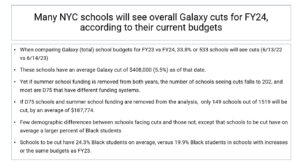
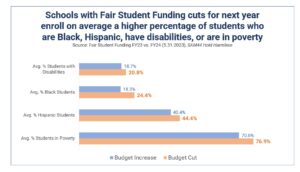 While the DOE stated that no initial school budgets for next year would be cut compared to initial budgets this year, more than a third (33.8%) of NYC public schools show a cut in their total Galaxy budgets for next year as of June 14, 2023 compared to their budgets for this school year, as of June 13, 2022.
While the DOE stated that no initial school budgets for next year would be cut compared to initial budgets this year, more than a third (33.8%) of NYC public schools show a cut in their total Galaxy budgets for next year as of June 14, 2023 compared to their budgets for this school year, as of June 13, 2022.
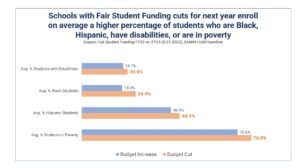 Even though overall Galaxy budgets increased by $259 million as of that date, there were more than 530 schools experiencing cuts in their total budgets by an average of $408,381 each, or 5.5%, according to our spreadsheet and analysis here, using data from the DOE’s Galaxy look-up tool downloaded on those respective dates.
Even though overall Galaxy budgets increased by $259 million as of that date, there were more than 530 schools experiencing cuts in their total budgets by an average of $408,381 each, or 5.5%, according to our spreadsheet and analysis here, using data from the DOE’s Galaxy look-up tool downloaded on those respective dates.
However, when summer school funding is deleted for FY 23 and FY 24, only 202 schools are seeing cuts; and many of the cuts affect D 75 schools, which have a different funding system and possibly on a different timetable, which we do not understand.
When both summer school funding and D75 schools are removed from the analysis, only 149 of out of 1519 schools are seeing cuts, averaging $187,774 each. Those schools seeing overall Galaxy cuts vs those with no cuts do not differ much in terms of their school populations, except they are more likely to have higher percentages of Black students, 24.3% on average, versus 19.9% Black students for those schools not seeing cuts.
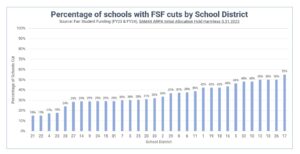 Fair Student Funding, which schools rely primarily for their staffing needs, is a different story. While the total amount allocated towards Fair Student Funding has also increased by nearly $200 million, nearly 35% or 529 schools also had their Fair Student Funding amounts reduced, based on DOE School Allocation memo number 44. Neither summer school funding nor D75 schools are included in this funding stream. The average cut for these 529 schools was $228,687 or 5.5% each.
Fair Student Funding, which schools rely primarily for their staffing needs, is a different story. While the total amount allocated towards Fair Student Funding has also increased by nearly $200 million, nearly 35% or 529 schools also had their Fair Student Funding amounts reduced, based on DOE School Allocation memo number 44. Neither summer school funding nor D75 schools are included in this funding stream. The average cut for these 529 schools was $228,687 or 5.5% each.
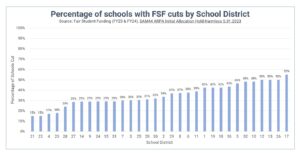 Most troubling: our demographic analysis reveals that schools that enroll larger percentages of Black and Hispanic students, students in poverty, those with disabilities, and Native American students are more likely to have cuts in their FSF allocations. [Check out the tab called “Demographic Analysis” in the spreadsheet linked to above; or the slide to the left.] In addition, schools face the potential peril of having to return a portion of their FSF mid-year if their enrollment falls below projected levels in the fall.
Most troubling: our demographic analysis reveals that schools that enroll larger percentages of Black and Hispanic students, students in poverty, those with disabilities, and Native American students are more likely to have cuts in their FSF allocations. [Check out the tab called “Demographic Analysis” in the spreadsheet linked to above; or the slide to the left.] In addition, schools face the potential peril of having to return a portion of their FSF mid-year if their enrollment falls below projected levels in the fall.
These FSF cuts are still likely to have a negative impact on schools, because even if they are receiving allocations in other categories to make up for these cuts, they may not be able to use this other funding to keep teachers on staff, since Galaxy totals combine funding streams for many different and often restrictive purposes. And even if schools receive more allocations in other categories later over the summer and into the next school year, it is often too late for schools hire more teachers.
This helps explain why we are already hearing from several schools which are being forced to excess teachers or unable to replace teachers who are leaving. We expect that this loss of teaching positions may lead to higher class sizes, and/or the loss of important art programs yet again. Please ask your principal or SLT if this will be true for your school, and if so, email us at [email protected].
Click on any of the slides above or the summary table below to be able to see them larger.








